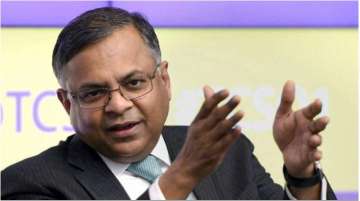World economy to see 'worst contraction' in 2020; steel output, demand to fall: Tata Group Chairman
Steel demand is expected to decline significantly in 2020-21 in line with a projected contraction in the global economy due to the impact of coronavirus pandemic, Tata Steel has said in its annual report.

Steel demand is expected to decline significantly in 2020-21 in line with a projected contraction in the global economy due to the impact of coronavirus pandemic, Tata Steel has said in its annual report.
Most of the steel producing regions are expected to witness a decline in crude steel output due to production cuts amidst ongoing lockdowns, Tata Steel said.
The global economic growth is expected to see a contraction of over 3 per cent in 2020, Tata Steel Chairman N Chandrasekaran said terming the slump as the "worst contraction" since the 1930s.
A contraction in the global GDP is not at all a good sign for the global steel sector as steel demand is positively correlated with the economic growth.
"Global GDP growth eased to 2.9 per cent in 2019, against an initial growth projection of 3.5 per cent... As we look ahead, it is important to gauge COVID-19's unprecedented impact on the global economy. It is expected that global growth will contract by over 3 per cent in 2020, the worst contraction since the 1930's," Chandrasekaran said in the Annual Report for 2019-20.
Chandrasekaran also said that this is for the first time since the Great Depression, that both advanced and developing economies are in recession together.
The impact of the slowing economy was also felt in the global steel sector. Global crude steel production reached 1,870 million tonne (MT) in 2019, registering a more modest growth of 3.4 per cent in 2019 against 4.6 per cent in 2018, he said.
In India also, he said, the growth slowed to 4.2 per cent in FY 2019-20 against an initial growth projection of 7.5 per cent in the beginning of the year.
The domestic steel sector registered a stark easing of growth to 1.8 per cent in 2019 compared to 7.7 per cent growth in the previous year.
The country was just beginning to show signs of coming out of a protracted slowdown that began in early 2018 when COVID-19 arrived, Chandrasekaran added.
Tata Steel's CEO and MD T V Narendran, and Executive Director and CFO Koushik Chatterjee said FY2020 was undoubtedly a challenging year not just for the company but for most businesses across the globe. Almost all countries faced a slowdown in economic growth amidst rising trade tensions and policy uncertainties.
This had its bearing on the steel industry as well, in terms of weak demand and falling steel prices. Making matters worse, the COVID-19 outbreak in early 2020 brought global economic activities to a near standstill as nationwide lockdowns and social distancing norms were imposed to contain the spread in the affected countries.
"Although the manufacturing sector is expected to stage a relatively quick recovery, supply chain disruptions are likely to continue. The key steel-consuming sectors will continue to be sluggish," the report said.
On the outlook of the steel sector, the company report said the COVID-19 pandemic has severely affected economies and industries globally and the steel industry is no exception.
"Outlook for the steel industry includes scenarios regarding the pandemic's speed of propagation, possible recurrence, near-term impact of measures being taken to contain the outbreak, and the effectiveness of the stimulus announced by the governments of various nations. After slower than expected growth in 2019, steel demand is estimated to contract significantly in the FY21," it said.
Most of the steel producing regions are expected to witness a decline in crude steel output due to production cuts amidst ongoing lockdowns. However, it is expected that compared to other countries, China will move faster towards normalisation of economic activity as it was the first country to come out of the COVID-19 crisis.
In India, it said, muted demand and oversupply is likely to result in suppressed steel prices and capacity utilization in the near term. Since India depends largely on migrant labour, restarting construction and infrastructure projects will be a challenge.
The demand from infrastructure, construction, and real estate sectors is likely to be subdued in the first half of the FY21 due to the lockdown during the first quarter followed by the monsoons during the second quarter.
Further, the demand from automobile, white goods, and capital goods sectors is likely to reduce significantly with consumers deferring discretionary spends in the near term. Effective government stimulus and return of consumer confidence is likely to be the key driver for a gradual recovery over the second half of the FY2021, it said.